Improvisation in Black
- Title
- Improvisation in Black
- Date
- 2021
- Dimensions
- 46” x 66” (117 x 168 cm)
- Media
- Handwoven textile utilizing cotton and linen yarns. The fabric utilizes woven shibori resist. Dyed with indigo and various red and yellow based dyes.
There is no single source of black in the “catalog” of natural dyes. I, not so long ago. took on a small weaving commission that required the use of black wool yarn. For a brief moment I contemplated purchasing commercially pre-dyed wool in the required color but I then decided that I could dye it myself, using natural color. I was surprised at how easy it was to achieve a rich, deep “black” color on the wool yarn by using only indigo and madder. That small accomplishment inspired me to continue my current series of color studies in cotton and linen with an in-depth exploration of “black” dyes - or more correctly, ways to achieve an acceptable black using only natural sources of color.
Initially, to further understand the process, I wanted to achieve all the black hues without the use of iron. My years of mixing synthetic dyes using primary colors gave me the confidence to believe that I could mix a good black using 3 colors: blue, red, and yellow. The key would be to determine the correct proportions to use with the natural dyes.
The first step was to build up a deep layer of indigo blue (usually 8-10 lengthy dips in the vat) followed by a mordant, a then a red or yellow based dye. These combinations of dyes included madder, cutch, black walnut, and weld.
Each combination of dyes resulted in a subtle hue variation. Some “blacks” are more purple, while others are a bit more green, or brown. Each is a distinct hue, and definitely in the “black” family, yet maybe not a “true black”.
I have confidence in the durability of these hues because all of the dyes used are proven to be very stable and fast to light.
No exploration of black could be complete without some experiments using tannin and iron. Instead of building up layers of primary colors, as described above, I soaked the textile in a gall nut tannin bath, followed by a short immersion in an iron bath.
I used both ferrous sulfate and ferrous acetate, which is less damaging to any fiber. The ferrous acetate will result in deeper shades versus the same amount of ferrous sulfate. This is as a result of the pH difference of the two mordants.
Refer to this blog post for more images and information regarding the use of ferrous sulfate vs. ferrous acetate.
Dyes used on individual panels, in the order pictured above:
|
#1 gall nut tannin + 1% ferrous acetate |
#3 indigo + 50% madder 50% weld |
#5 Indigo + black walnut 30% madder |
#7 indigo + 50% madder |
#9 indigo + 30% madder 50% weld |
#11 indigo + 10% madder 50% weld |
|
#2 gall nut tannin + 1% ferrous sulfate |
#4 indigo + 15% cutch 30% madder |
#6 indigo + 15% cutch |
#8 indigo + black walnut 15% cutch |
#10 indigo + black walnut |
#12 indigo + 10% madder 10% weld |
